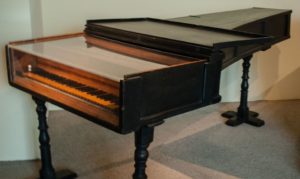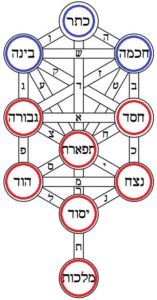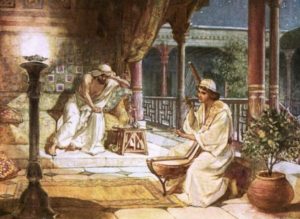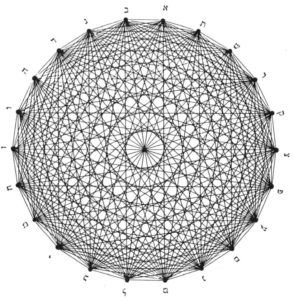In parashat Korach, we read how “the earth opened her mouth and swallowed them up, and their households, and all the men that were with Korach” (Numbers 16:32). Evidently, Korach and his entire family perished. Yet, later on the Torah tells us: “And the earth opened its mouth and swallowed them up with Korach… but the sons of Korach did not die.” (Numbers 26:10-11) Apparently, his sons actually survived! We know this must be the case because there are a number of Psalms (such as numbers 42 to 49) which begin with a byline saying they were written by the “sons of Korach”. How is this possible?
Midrash Aggadah comments on Numbers 26:11 that just as the sons of Korach were falling into the pit, as they felt the heat of the flames upon them, they suddenly “began to sing, as mentioned in Psalms, ‘For the composer, on the shoshanim, by the sons of Korach…’ (Psalms 45:1) meaning that they made their hearts soft like shoshanim [roses]…” and repented wholeheartedly at that moment. The three sons Asir, Elkanah, and Aviasaf went on to become great musicians, and are immortalized in the Book of Psalms.
The implication here is that music had the power to save the sons of Korach from the flames of the netherworld! Through their song (and the future songs they would compose), they merited to be saved. Indeed, throughout the Tanakh we see the importance of music in elevating people spiritually, inspiring them to repent, or healing them of distress. For example, in II Kings 3:15 we read how the prophet Elisha wanted to enter a prophetic state, so he said: “bring me a musician. And it came to pass, when the musician played, that the hand of God came upon him.”
The Chatam Sofer (Rabbi Moshe Schreiber, 1762-1839) comments on the above verse that the word zemer (זמר), “music”—when transformed using the avag-beged (אבג-בגד) system (where a letter is replaced with the letter that follows after it)—spells nachash (נחש), “serpent”. He explains that music has the power to drive away the Primordial Serpent which incites people to sin. Music can remove the spirit of the evil inclination from a person, causing tremendous spiritual elevation, even to the point of attaining prophecy. The Zohar (II, 45a) goes so far as to state that the difference between Moses and all the other prophets is that Moses alone did not need music to enter a state of prophecy!
While few are worthy of prophecy, many need music for therapeutic purposes. We see this first with King Saul:
Now the spirit of God had departed from Saul, and an evil spirit sent by God terrified him. And Saul’s servants said to him: “Behold, an evil spirit from God terrifies you. Let our lord now command your servants that are before you, to seek out a man who is a skillful player on the harp; and it shall be, when the evil spirit from God comes upon you, he shall play with his hand, and you shall be well.” (I Samuel 16:14-16)
This is how David enters the royal scene, hired to play music for Saul: “David came to Saul, and stood before him; and he loved him greatly; and he became his armour-bearer.” (v. 21) David was an expert player of the kinor, harp, a fairly simple string instrument. (In Modern Hebrew, “kinor” refers to a violin which, of course, didn’t exist in the time of David.) The Talmud (Berakhot 3b) states that David actually had a harp hanging over his bed, and when a strong northerly wind blew in each midnight, it would pluck the strings and serve as an alarm clock. David would arise to pray, learn Torah, and compose his holy psalms.
Like his ancestor and spiritual root, Mashiach, too, must be a musician. In fact, the Talmud (Sanhedrin 94a) recounts how King Hezekiah was supposed to be the messiah, but then the Heavens protested because he was not a musician and never sang songs before God! The Talmud states that this is actually the secret behind the unique case in the Tanakh where a closed mem sofit—always at the end of a word—strangely appears in the middle of a word (לםרבה). This is in Isaiah 9:6, which states:
That the government may be increased (לםרבה), and of peace there be no end, upon the throne of David, and upon his kingdom, to establish it, and to uphold it through justice and through righteousness from now and forever…
The eternal throne of David could have been solidified with King Hezekiah, but the opportunity for redemption was shut (hence the closed mem) because he was not a musician. What kind of music is Mashiach supposed to play? What is his instrument?
Divine Octave
The Zohar describes the music of the messiah in detail (see Tikkunei Zohar 21, page 51b). He will introduce a special song to be sung at the End of Days, which was alluded to at the Splitting of the Sea when the Torah says az yashir Moshe u’vnei Israel, “Then Moses and the Children of Israel will sing…” (Exodus 15:1) The Torah should have said that they sang, in the past tense, yet it strangely speaks in future tense. The classic explanation for this is that it is alluding to the final Song of Redemption.
The Zohar delves into the meaning of the first word az (אז). It has a numerical value of 8 to signify the Octagrammaton (יאהדונהי), the “fused” eight-letter name of God which combines the Ineffable Tetragrammaton, Yud-Hei-Vav-Hei, with Adonai. This special name represents the fusion of Heaven and Earth, since the Tetragrammaton is the Heavenly name that is unpronounced, while Adonai is the way we refer to God on Earth below. When combined, it forms a “bridge” between the realms. The gematria of the Octagrammaton is 91, a number which represents that fusion of Heaven and Earth. This is why, for instance, the value of sukkah (סוכה) is 91, as the sukkah is the place where one can experience the Heavenly Clouds of Glory here on Earth. The same number is the value of “angel” (מלאך), for angels are those beings that bridge Heaven and Earth and freely move between these realms.
Since, as we have seen, music has the ability to elevate souls Heavenward, and to bring Heaven “down to Earth”, so to speak, the Zohar states that is connected to the number 8, and is spiritually rooted in the Octagrammaton. Of course, we describe music in terms of octaves, “eights”. A perfect octave has the seven musical notes in sequence, with the eighth note being the same as the first note but double the frequency (do-re-mi-fa-sol-la-ti-do, or C-D-E-F-G-A-B-C). This is a beautiful mirror of the Octagrammaton (יאהדונהי), which begins and ends with a yud, each of which can similarly be described as coming from a different “frequency”: the higher “frequency” of Hashem above, and the lower “frequency” of Adonai below. (One shouldn’t, God forbid, err in thinking there are two deities! It is one God expressed in two different realms, like one note expressed through two different frequencies.)
Not surprisingly, the Zohar states that Mashiach makes music specifically through the power of the Octagrammaton, through the power of 8. This is the secret of King David’s instruction in Psalms 12:1, “For the conductor on the shminit…” where shminit (שמינית) is the name of a mysterious instrument, and on a deeper level signifies the 8 (שמונה). The Zohar points out that, of course, David mainly played a kinor, a harp, and presumably so does Mashiach. But Mashiach’s harp is not quite a harp—it is capable of much more.
Mashiach’s Piano
In the Middle Ages, as music developed further and became more and more complex, so did musical instruments. The harp grew larger and larger, with more and more strings, to the point where it was difficult to play upright, directly with the hands. So, musicians laid down the harp horizontally, and created a mechanism where the strings can be plucked indirectly, through a keyboard. This new, superior derivation of the harp was called the harpsichord. However, the harpsichord had some issues of its own.
One of the issues with the harpsichord was that there was no good way to regulate volume. It didn’t matter how hard you pressed the keys—the sound was always the same! Certain tedious means were devised to deal with this, though not very effectively. A new mechanism was needed to allow easily adding more flavour and emotion to the music. Enter Bartolomeo Cristofori (1655-1731).
Cristofori devised a new system where, instead of plucking the strings, the harpsichord had hammers. This would allow a musician to regulate volume based on how hard they hit the key. Cristofori called his instrument the “harp-harpsichord”, but it became known as the piano. (From Latin planus, literally a “plane”, the piano essentially being a harp lying on a plane. Of course, later pianos became upright again to save space!)

An original Cristofori piano from 1720 – currently on display at New York’s Metropolitan Museum of Art
The piano became the instrument, the foundation of all Western music. It is the lone instrument that covers the entire musical scale, with a range that is incomparable. Whereas almost every other instrument allows a player to really only hit one or several notes at a time, the piano allows a player to hit ten notes simultaneously (plus foot pedals to make the sound even richer). The complexity of sound that a piano can produce is unparalleled, as is its ability to touch the soul. What’s more amazing is that everything about the piano exudes mysticism.
A Musical Universe
As the piano evolved, it came to a certain standard form: 7 octaves with 7 white keys each; 36 additional black keys for a total of 88, plus 3 pedals, and about 230 strings hidden beneath. Each of these numbers carries tremendous significance.

The three higher Sefirot of mochin above (in blue) and the seven lower Sefirot of the middot below (in red) on the mystical “Tree of Life”.
The 7 octaves of 7 white keys follow the same arrangement as the lower seven Sefirot—like we count during the Omer, where each of the seven days in each of the seven weeks corresponds to one inner Sefirah. Peculiarly, a normal piano always has an extra three white keys that are almost never used. These neatly correspond to the additional three higher Sefirot of the mochin that similarly seldom play a visible role in our material world. (To make it even more perfect, there is also an extra black key wedged between them, to remind of the inner/alternate Sefirah of Da’at wedged within the mochin!)
There are a total of 36 black keys sitting atop the white ones. (The black on white often reminds me of the mystical description of the Torah being “black fire on white fire”.) The number 36 represents the Or HaGanuz, the Divine Light of Creation that initially shone for 36 hours before being concealed and preserved for the World to Come. As discussed before, the 36 correspond to the 36 individual texts of the Tanakh (combined into 24 books for easier publication), the 36 candles of Chanukah, and the 36 hidden tzadikim that keep the world going at any given time, Mashiach being one of them. As the Midrash states in multiple places, it will be Mashiach’s job to restore this Hidden Light to the world in the time to come (see for example, Yalkut Shimoni on Isaiah 60, passage 499).
Altogether, the piano has 88 keys. This is the total number of constellations, mazalot, in the night sky. It is one of the numbers that symbolizes the Heavens. As we’ve seen, music comes from the power of the shminit, the 8 of the Octagrammaton, and serves to bridge Heaven and Earth. When adding the three pedals to the 88 keys, the piano allows the player to hit any of 91 switches. Recall that 91 is the gematria of the Octagrammaton, that number representing the bridge between Heaven and Earth.
Concealed underneath all this are the actual vibrating strings which produce the sound. Some keys are connected to one string, others to two strings, and the higher ones to three strings. A piano might have anywhere from 220 to 240 strings, but the most common number is 230 or 231. This, too, is a fitting number, for Sefer Yetzirah speaks of 231 secret Heavenly gates. These gates emerge out of all the possible combinations of the Hebrew letters (aleph with beit, aleph with gimel, aleph with dalet, etc.)—which might themselves be described as “vibrating strings”.
It is with those combinations of Hebrew letters that God created the universe. And science has now reduced the entirety of the universe to a set of invisibly-small vibrating strings. That is, at least, according to string theory, currently the most viable “grand unified theory” that seeks to explain everything in existence. Like a piano, it seems that the entire universe is little more than vibrating strings!* Long ago, Perek Shirah already told us that everything in the universe is secretly singing. (It even tells us what each thing is singing.) There is music all around us. Are you listening?
*In addition to the harp, King David also played a smaller and more portable version of the instrument, the lyre. In the Tanakh, it is typically called a nav’el (נבל). In the Aramaic portion of the Book of Daniel (3:5), it has a different name: kitaras (קיתרס). This term evolved into today’s “guitar”! Like the lyre, the guitar originally had seven strings, though today guitars usually have six. The same verse in Daniel mentions a psanterin (פסנתרין), the origin of the Modern Hebrew word for a piano, psanter. As we read in Psalm 92:4 and other places, King David played both the nav’el and the kinor, ie. both the kitaras and the psanter. Amazingly, the gematria of the two together (נבל + כנור) is 358, equal to Mashiach (משיח)!




Pingback: Holy Cow: Parallels between Judaism and Hinduism | Mayim Achronim
Pingback: Who is Mashiach? | Mayim Achronim
Pingback: The Meaning and Power of “Amen” | Mayim Achronim
Pingback: Listening to Non-Jewish Music | Mayim Achronim
Pingback: Who Entered the Holy Land? | Mayim Achronim
Pingback: Music on Shabbat and in the Temple | Mayim Achronim